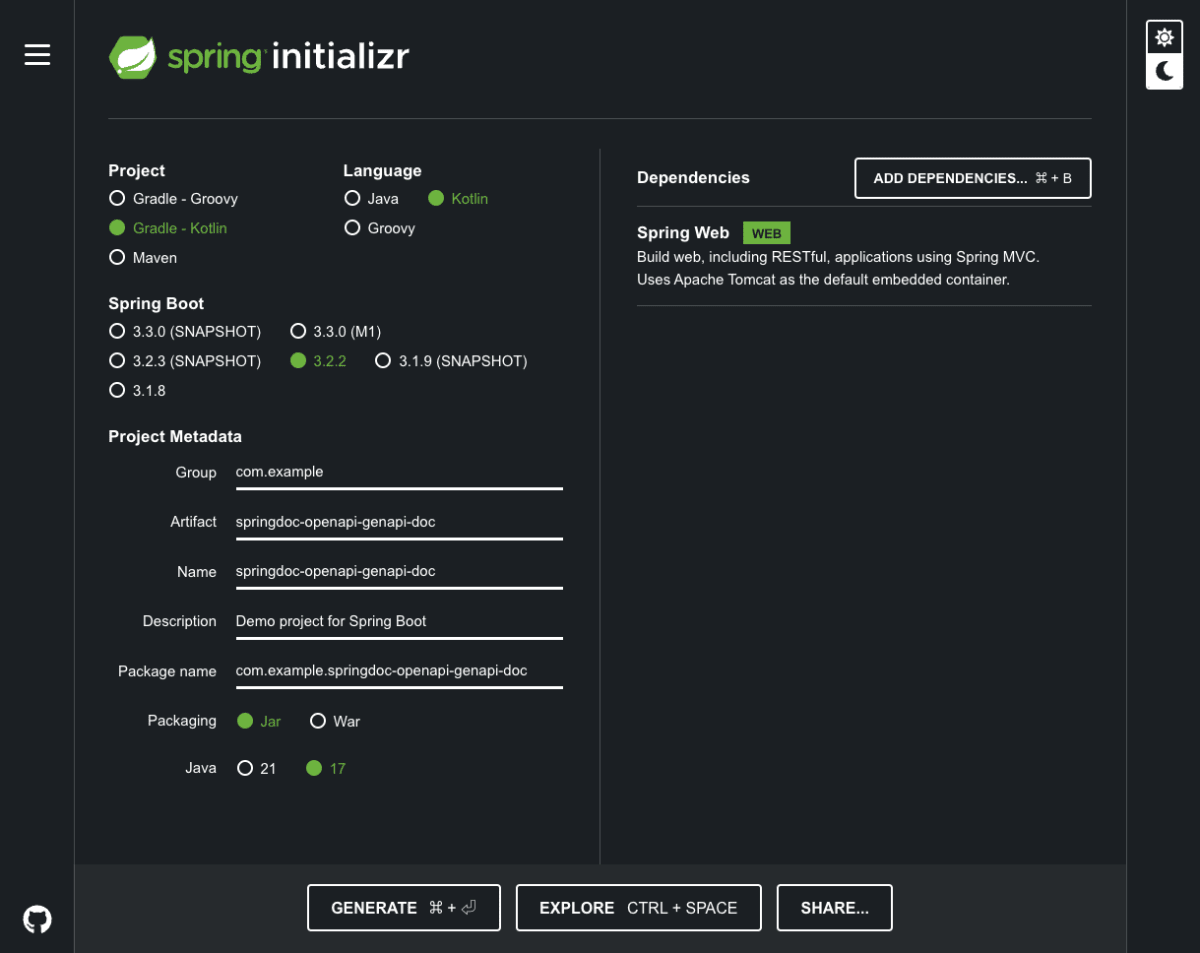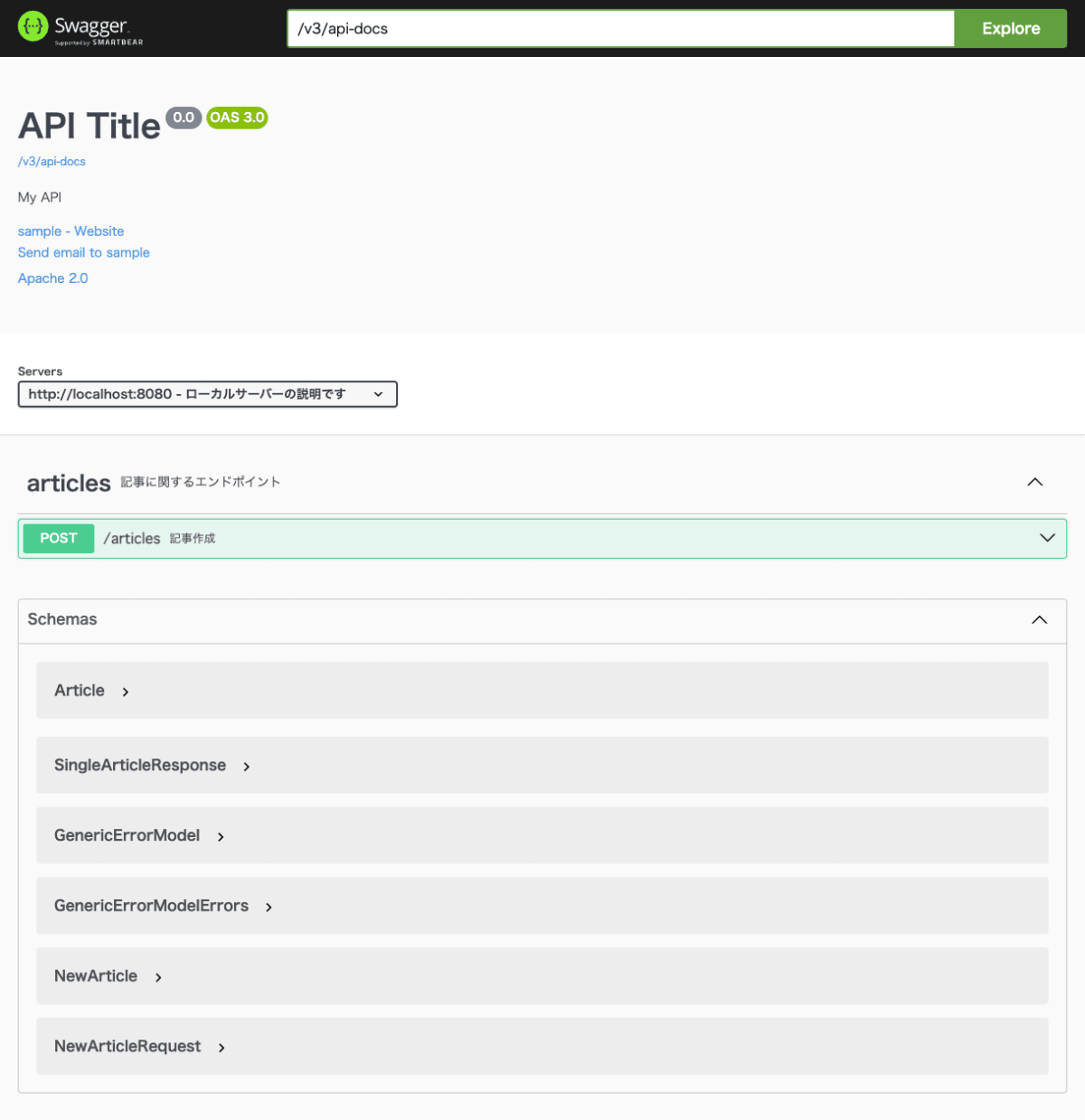Kotlin + Spring Boot 3 + Springdoc-openapi で OpenAPI ドキュメントを作成する
概要
本記事では、Spring Boot のアノテーションから OpenAPI のドキュメントを生成するライブラリ Springdoc-openapi を Kotlin で実践します。
プロジェクトへ導入
本項ではプロジェクトへの導入方法を以下の手順で説明します。
- Spring Initializr でプロジェクトを作成
- build.gradle.kts の設定
Spring Initializr でプロジェクトを作成
まずは、Spring Initializr で Spring Boot プロジェクトを作成します。
本記事では以下の内容で作成しました。
| 項目 | 内容 | 補足 |
|---|---|---|
| Project | Gradle Kotlin | |
| Language | Kotlin | |
| Spring Boot | 3.2.2 | 時期によって選択できるバージョンが変わります。3 系のスナップショットでない方を選んでください。 |
| Artifact | springdoc-openapi-genapi-doc | |
| Name | springdoc-openapi-genapi-doc | Artifact を入力したら自動で更新されます |
| Description | Demo project for Spring Boot | デフォルトのままです |
| Java | 17 | |
| Dependencies | Spring Web |

Spring Initilizar 入力後
以下に入力済みの Spring Initializr のリンクを記載します。
作成したアプリケーションを適当なディレクトリに写して unzip してください。
build.gradle.kts の設定
プロジェクトを開いて、インデックスの作成を終えたら、build.gradle.kts を編集します。
具体的には、build.gradle.kts に SpringDoc の plugin と dependencies を記述します。
下記の例では、validation を有効化するため、Spring Boot Starter Validation も記載しています。
plugins {
// 略
/**
* springdoc
*
* URL
* - https://springdoc.org/
* Main 用途
* - OpenAPI 仕様に基づいたドキュメントを生成する
* Sub 用途
* - なし
* 概要
* コードから OpenAPI 仕様に基づいたドキュメントの生成ライブラリ
*/
id("org.springdoc.openapi-gradle-plugin") version "1.8.0"
}
dependencies {
// 略
/**
* Spring Boot Starter Validation
*
* MavenCentral
* - https://mvnrepository.com/artifact/org.springframework.boot/spring-boot-starter-validation
* Main用途
* - コントローラーのバリデーションのために利用する
* Sub用途
* - 無し
* 概要
* - Validation を実装した際に、本ライブラリがなければ、バリデーションが動作しない
*/
implementation("org.springframework.boot:spring-boot-starter-validation")
}
また、dependencies に以下を記入します。この内容は SpringDoc を CLI から生成するために必要です。
dependencies {
// 略
/**
* springdoc の gradle 拡張
*
* 概要
* - CLI から springdoc を利用して OpenAPI を 生成する
*/
implementation("org.springdoc:springdoc-openapi-starter-webmvc-ui:2.3.0")
}
最後に、openapi.yaml を生成するコマンドを記述します。
上から順番に以下の内容になっています。
- http://localhost:8080/v3/api-docs.yaml の yaml ファイルから
- build/springdoc ディレクトリに
- openapi.yaml という名前で作成する
openApi {
apiDocsUrl.set("http://localhost:8080/v3/api-docs.yaml")
outputDir.set(project.layout.buildDirectory.dir("springdoc"))
outputFileName.set("openapi.yaml")
}
以上の設定から以下のコマンドで build/springdoc/openapi.yaml に生成できます。
しかし、すでにファイルが存在するか、キャッシュが存在していると、上書きされません。
そのため筆者は、rm build/springdoc/openapi.yaml で削除して逐次実行しています。
特筆しなければ毎回削除してから実行していると考えてください。
./gradlew generateOpenApiDocs
また、SpringBoot アプリケーションを起動した状態だと、http://localhost:8080/swagger-ui/index.html に Swagger UI で表示できます。
アノテーションの記述方法
本項では、SpringBoot のサンプルアプリケーションで具体的なアノテーションの記述方法を記載します。
DB とは接続しませんが、「新規記事を作成するエンドポイントを持つ Web API」という設定のコードを作成します。
完成したサンプルコードは以下に記載しています。
アノテーションの記述方法は以下の swagger-api の GitHub に記載されています。
本記事では基本的な部分の説明に注力し、OpenAPIDefinition、Operation、Media アノテーションのみ取り扱います。
OpenAPIDefinition アノテーション
OpenAPIDefinition アノテーションは OpenAPI の定義について記述するアノテーションです。
具体的には以下のようなアノテーションが含まれています。
- @OpenAPIDefinition
- @Info
- @License
下記のように、OpenAPIDefinition によって、API 名、ライセンス、サーバ情報などを取得できます。
以下のように、@SpringBootApplication を付与するクラスに@OpenAPIDefinition アノテーションを記述します。
今回の例では Server アノテーションが記述されていますが、Server アノテーション自体は後述する Operation アノテーションに含まれています。
/**
* SpringdocOpenapiGenApidocApplication
*/
@SpringBootApplication
@OpenAPIDefinition(
info = Info(
title = "API Title",
version = "0.0",
description = "My API",
license = License(name = "Apache 2.0", url = "http://sample"),
contact = Contact(url = "http://sample.com", name = "sample", email = "sample@sample.com")
),
servers = [
Server(
description = "ローカルサーバーの説明です",
url = "http://localhost:8080",
),
Server(
description = "事前環境サーバーの説明です",
url = "http://stg:8080",
),
Server(
description = "本番環境サーバーの説明です",
url = "http://prod:8080",
),
],
)
class SpringdocOpenapiGenApidocApplication
Operation アノテーション・Media アノテーション
続いて、Operation アノテーションと Meida アノテーションについて説明します。
リクエストボディ、レスポンスボディ、コントローラなどに記述し、メソッドごとの API 定義・サンプルや OpenAPI のタグの設定をします。
Operation アノテーションには以下のアノテーションなどが含まれます。
メソッドの定義やリクエストパラメータ、レスポンスの定義などを設定します。
Media アノテーションには以下のアノテーションなどが含まれます。
@Schema アノテーションはフィールドの説明や必須かどうかを説明したり、@ApiResponse アノテーションと組み合わせてレスポンスのスキーマ定義やサンプルを表示します。
それぞれ、リクエストボディ、レスポンスボディ、コントローラの例を記述します。
リクエストボディ
次の例は、新規記事作成リクエストボディの data class です。
@Schema アノテーションが必須かどうかや説明を記述しています。
/**
* 新規記事作成のリクエストモデル
*
* @property article
*/
data class NewArticleRequest(
@field:Valid
@field:NotNull
@Schema(required = true, description = "記事を作成する時のリクエスト")
@field:JsonProperty("article", required = true) val article: NewArticle? = null
)
/**
* NewArticle
*
* 新規記事のモデル
*
* @property title タイトル
* @property description 説明
* @property body 本文
*/
data class NewArticle(
@field:Size(max = 32)
@field:NotBlank
@Schema(example = "new-article-title", required = true, description = "新規記事のタイトル")
@field:JsonProperty("title", required = true) val title: String? = null,
@field:Size(max = 1024)
@field:NotBlank
@Schema(example = "new-article-description", required = true, description = "新規記事の説明")
@field:JsonProperty("description", required = true) val description: String? = null,
@field:Size(max = 2048)
@field:NotBlank
@Schema(example = "new-article-body", required = true, description = "新規記事の説明")
@field:JsonProperty("body", required = true) val body: String? = null,
)
レスポンスボディ
以下は、新規記事作成のレスポンスボディです。
レスポンスボディもリクエストボディと基本的には同様でフィールドにスキーマを定義します。
/**
* 単一記事のレスポンスモデル
*
* @property article
*/
data class SingleArticleResponse(
@field:Valid
@Schema(required = true, description = "新規記事")
@field:JsonProperty("article", required = true) val article: Article
)
/**
* Article
*
* 記事のモデル
*
* @property slug スラッグ
* @property title タイトル
* @property description 説明
* @property body 本文
*/
data class Article(
@get:Size(max = 32)
@Schema(example = "article-slug", required = true, description = "")
@field:JsonProperty("slug", required = true) val slug: String,
@get:Size(max = 64)
@Schema(example = "article-title", required = true, description = "")
@field:JsonProperty("title", required = true) val title: String,
@get:Size(max = 1024)
@Schema(example = "article-description", required = true, description = "")
@field:JsonProperty("description", required = true) val description: String,
@get:Size(max = 4096)
@Schema(example = "article-body", required = true, description = "")
@field:JsonProperty("body", required = true) val body: String
)
以下はエラーレスポンスを返すときの data class です。
/**
* GenericErrorModel
*
* エラーレスポンスを返す時に利用するモデル
*
* @property errors
*/
data class GenericErrorModel(
@field:Valid
@Schema(required = true, description = "")
@field:JsonProperty("errors", required = true) val errors: GenericErrorModelErrors
)
/**
* GenericErrorModelErrors
*
* エラーレスポンスの詳細を記述するモデル
*
* @property body エラーの詳細
*/
data class GenericErrorModelErrors(
@Schema(required = true, description = "")
@field:JsonProperty("body", required = true) val body: List<String>
)
コントローラ
最後にコントローラについて説明します。
基本的な SpringBoot のアノテーションに加えて、SpringDoc のアノテーションも記述しています。
具体的には Operation アノテーション、Tag アノテーション、Content アノテーション、Schema アノテーションなどを利用しています。
Tag アノテーションで openapi.yaml の生成時にタグによるグルーピングをします。
Operation アノテーションで、メソッドごとの説明を記述したり、レスポンスのスキーマは具体例を記述できます。
/**
* SpringDoc のサンプルアプリ用 ArticleController
*/
@RestController
@Tag(name = "articles", description = "記事に関するエンドポイント")
@Validated
class ArticleController {
/**
* 記事作成エンドポイント
*
* @param newArticleRequest
* @return
*/
@Operation(
summary = "記事作成",
operationId = "createArticle",
description = "記事を作成します。",
responses = [
ApiResponse(
responseCode = "201",
description = "OK",
content = [
Content(
schema = Schema(implementation = SingleArticleResponse::class),
examples = [
ExampleObject(
name = "OK",
value = """
{
"article": {
"slug": "new-slug",
"title": "new-title",
"body": "new-body",
"description": "new-description"
}
}
"""
)
]
)
]
),
ApiResponse(
responseCode = "400",
description = "Validation Error",
content = [
Content(
schema = Schema(implementation = GenericErrorModel::class),
examples = [
ExampleObject(
name = "ValidationError",
value = """
{
"errors": {
"body": [
"article.titleは0文字以上32文字以下です",
"article.bodyは必須です"
]
}
}
"""
)
]
)
]
),
ApiResponse(
responseCode = "409",
description = "Already Exists",
content = [
Content(
schema = Schema(implementation = GenericErrorModel::class),
examples = [
ExampleObject(
name = "AlreadyExists",
value = """
{
"errors": {
"body": [
"記事はすでに存在しています"
]
}
}
"""
)
]
)
]
)
]
)
@PostMapping(
value = ["/articles"],
produces = [MediaType.APPLICATION_JSON_VALUE],
consumes = [MediaType.APPLICATION_JSON_VALUE],
)
fun createArticle(
@Parameter(
description = "新規記事作成",
required = true
)
// Sample プロジェクトのため、Suppress を利用。本番環境では削除する
@Valid @RequestBody @Suppress("UnusedParameter") newArticleRequest: NewArticleRequest,
): ResponseEntity<SingleArticleResponse> {
return ResponseEntity(
SingleArticleResponse(
article = Article(
slug = "new-slug",
title = "new-title",
body = "new-body",
description = "new-description"
)
),
HttpStatus.OK
)
}
/**
* 記事作成エンドポイントに発生した例外を表現するクラス
*
* @property error エラー
*/
data class CreateArticleErrorException(val error: Error) : Throwable()
/**
* 記事作成エンドポイントの例外をハンドリングする関数
*
* @param e
* @return
*/
@ExceptionHandler(CreateArticleErrorException::class)
fun onCreateArticleErrorException(e: CreateArticleErrorException): ResponseEntity<GenericErrorModel> {
// Sample プロジェクトのため、AlreadyExists 以外は BadRequest としてエラーレスポンスを返している
if (e.error.toString() == "AlreadyExists") {
return ResponseEntity(
GenericErrorModel(
errors = GenericErrorModelErrors(
body = listOf(e.error.toString())
)
),
HttpStatus.CONFLICT
)
}
return ResponseEntity(
GenericErrorModel(
errors = GenericErrorModelErrors(
body = listOf(e.error.toString())
)
),
HttpStatus.BAD_REQUEST
)
}
}
生成結果
以上の内容を踏まえて、openapi.yaml を生成します。
SpringBoot アプリケーションを起動して、http://localhost:8080/swagger-ui/index.html を参照すると、以下の画像のように表示されます。

Swagger UI
CLI から yaml ファイルを生成したい場合は以下のコマンドを実行します。
./gradlew generateOpenApiDocs
build/springdoc/openapi.yaml にファイルが生成され、結果は下記の折りたたみの通りです。
生成結果。
openapi: 3.0.1
info:
title: API Title
description: My API
contact:
name: sample
url: http://sample.com
email: sample@sample.com
license:
name: Apache 2.0
url: http://sample
version: "0.0"
servers:
- url: http://localhost:8080
description: ローカルサーバーの説明です
- url: http://stg:8080
description: 事前環境サーバーの説明です
- url: http://prod:8080
description: 本番環境サーバーの説明です
tags:
- name: articles
description: 記事に関するエンドポイント
paths:
/articles:
post:
tags:
- articles
summary: 記事作成
description: 記事を作成します。
operationId: createArticle
requestBody:
content:
application/json:
schema:
$ref: "#/components/schemas/NewArticleRequest"
required: true
responses:
"201":
description: OK
content:
application/json:
schema:
$ref: "#/components/schemas/SingleArticleResponse"
examples:
OK:
description: OK
value:
article:
slug: new-slug
title: new-title
body: new-body
description: new-description
"400":
description: Validation Error
content:
application/json:
schema:
$ref: "#/components/schemas/GenericErrorModel"
examples:
ValidationError:
description: ValidationError
value:
errors:
body:
- article.titleは0文字以上32文字以下です
- article.bodyは必須です
"409":
description: Already Exists
content:
application/json:
schema:
$ref: "#/components/schemas/GenericErrorModel"
examples:
AlreadyExists:
description: AlreadyExists
value:
errors:
body:
- 記事はすでに存在しています
components:
schemas:
Article:
required:
- body
- description
- slug
- title
type: object
properties:
slug:
maxLength: 32
minLength: 0
type: string
example: article-slug
title:
maxLength: 64
minLength: 0
type: string
example: article-title
description:
maxLength: 1024
minLength: 0
type: string
example: article-description
body:
maxLength: 4096
minLength: 0
type: string
example: article-body
description: 新規記事
SingleArticleResponse:
required:
- article
type: object
properties:
article:
$ref: "#/components/schemas/Article"
GenericErrorModel:
required:
- errors
type: object
properties:
errors:
$ref: "#/components/schemas/GenericErrorModelErrors"
GenericErrorModelErrors:
required:
- body
type: object
properties:
body:
type: array
items:
type: string
NewArticle:
required:
- body
- description
- title
type: object
properties:
title:
maxLength: 32
minLength: 0
type: string
description: 新規記事のタイトル
example: new-article-title
description:
maxLength: 1024
minLength: 0
type: string
description: 新規記事の説明
example: new-article-description
body:
maxLength: 2048
minLength: 0
type: string
description: 新規記事の説明
example: new-article-body
description: 記事を作成する時のリクエスト
NewArticleRequest:
required:
- article
type: object
properties:
article:
$ref: "#/components/schemas/NewArticle"
description: 新規記事作成
参考
Discussion